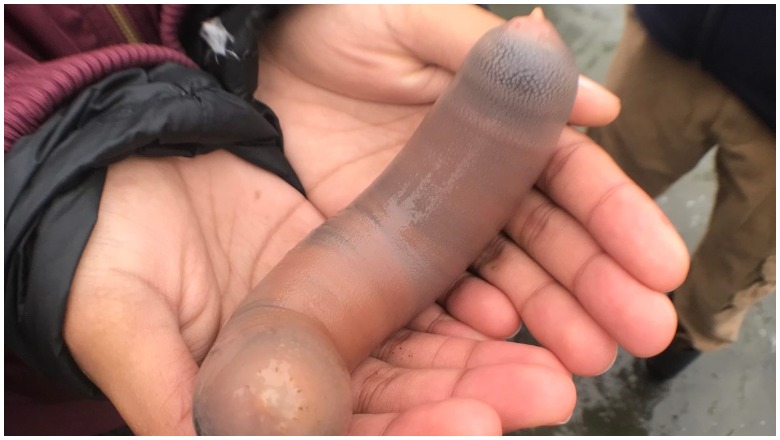
David Ford was visiting Drake’s Bay on the coast of Northern California when he saw what appeared to be thousands of severed penises washed up on the shore. They 10-inch-long pink creatures turned out to be innkeeper worms which are also known as “penis fish”.
“I had no idea what they might be…it went on for two miles,” Ford told Vice. “I walked for another half hour and they were scattered everywhere. There were seagulls lined up the beach the whole way having eaten so much they could barely stand. A quarter of them looked like they were still alive. The rest were dead, they had a dead sea-creature smell.”
Ford took the photo on December 6 and shared it with the magazine Bay Nature for their “Ask the Naturalist” segment. For the segment, Ford asked biologist Ivan Parr “I saw thousands of these on Drakes Beach on Dec. 6, after the recent storm. What happened?”
Parr responded in an article, “Naturally, 2019 Closes with Thousands of 10-Inch Pulsing ‘Penis Fish’ Stranded on a California Beach.”
“You could be forgiven for being offended by the above photo: thousands of 10-inch wiggly pink sausages strewn about Drakes Beach.” Parr wrote, “I’ve heard my share of imaginative theories from beachcombers, such as flotsam of a wrecked bratwurst freighter. In truth, these are living denizens of our beaches rudely, yet also mercifully, mostly called ‘fat innkeeper worms.'”
The worms are rarely seen as they live in U-shaped burrows underground their entire lives. But tropical storms can displace them by the tens of thousands, as David Ford saw on Drake’s Bay. “Strong storms – especially during El Niño years – are perfectly capable of laying siege to the intertidal zone, breaking apart the sediments, and leaving their contents stranded on shore.” Parr wrote.
The worms inhabit low intertidal to subtidal areas from Southern Oregon to Tijuana Slough, Mexico. They are usually spotted between Bodega Bay and Monterey, around 200 miles away.
Here’s what you need to know:
1. The Worms Are Considered a Delicacy in South Korea
Innkeeper worms are known as “gaebul” (개불), or “dog genitals”, in South Korean and are considered a delicious treat. The fish are known to be very chewy and very sweet from marinating in salt water for so long. Koreans use the word “dalchakjigeunhada” (달착지근하다) to describe the taste which means a natural, mildly pleasant sweetness that you’ll often taste in seafood.
The worms are sweetest and most plentiful from December to March. They are traditionally consumed raw after being dipped in sauce, usually chogochujang (초고추장, vinegared gochujang). Similar to oysters, they are meant to be cut up and eaten right away.
Not everybody eats them on the spot. Some locals near the West Sea sauté gaebul with kimchi and others skewer gaebul whole and grill it with a salt, pepper and sesame oil seasoning.
2. The Penis Fish Eats by Excreting a Mucous Net That Catches Its Food
According to Ivan Parr, the innkeeper worm spends most of its life underground. It “digs a U-shaped burrow extending a few feet in length but no wider than the worm itself. The burrow’s front entrance pokes up like a little sand chimney.” The chimneys can be seen clustered around the low tide line of a mudflat or sandy beach.
In order to eat, the worm exudes a mucous net from its glands that captures plankton and bacteria. As Parr describes it, “The worm continues to secrete as it slips lower into the burrow, generating a slime-net that stretches from the chimney to the worm’s mouth. Using contractions (peristalsis) to pump water through its burrow, the worm sucks plankton, bacteria, and other bits into this net. When, like any vacuum, the net gets clogged, the worm slurps it all back into its mouth, taking in the particles it wants to eat and discarding the rest into the tunnel.”
The leftover particles are consumed by various other creatures including clam (Cryptomya californica); a “sequined” scale-worm (Hesperonoe adventor); a pea crab (Scleroplax granulata or Pinnixa franciscana); a hooded shrimp (Betaeus longidactylus); and even a fish, the arrow goby (Clevelandia ios).
According to Parr, the innkeeper worms don’t mind. “In fact, it’s the textbook example of commensalism – a relationship in which (simply put) one organism forms a dependency on another, the latter being neither helped nor severely hurt in the relationship.”
3. Innkeeper Worms Have Been Around for 300 Million Years
There is fossil evidence that innkeeper worms have been around for hundreds of millions of years. Archaeologists have found U-shaped burrows dating back 300 million years, according to Ivan Parr.
Innkeeper worms can live up to 25 years but typically don’t due to their many predators including otters, flounders, sharks, rays, gulls, and humans
4. Penis Fish Have Washed up on Shore Before
Tropical storms have washed innkeeper worms on shore before, though it’s usually just a few rather than thousands at once. In a video from 2016, YouTube user Kim Powell posted a video from a school field trip hosted by Blue Water Adventures. She didn’t have to hunt the worm, a few had been displaced and were sitting on the beach at Elkhorn Slough on Monterey Bay, California.
5. Fisherman Use Them as Bait
Fisherman from around the world hunt and catch innkeeper worms and use them for bait. They are hard to find but very effective for catching fish. According to fisherman Ken Jones, “It was a bait especially prized by many of the croaker specialists, the solitary anglers who went out week after week in pursuit of the large spotfins.”
There are videos on YouTube from fisherman showing how to capture the creatures on the beach. Fishermen in Korea use them to catch flounder and sea bream.
READ NEXT: Headline Here